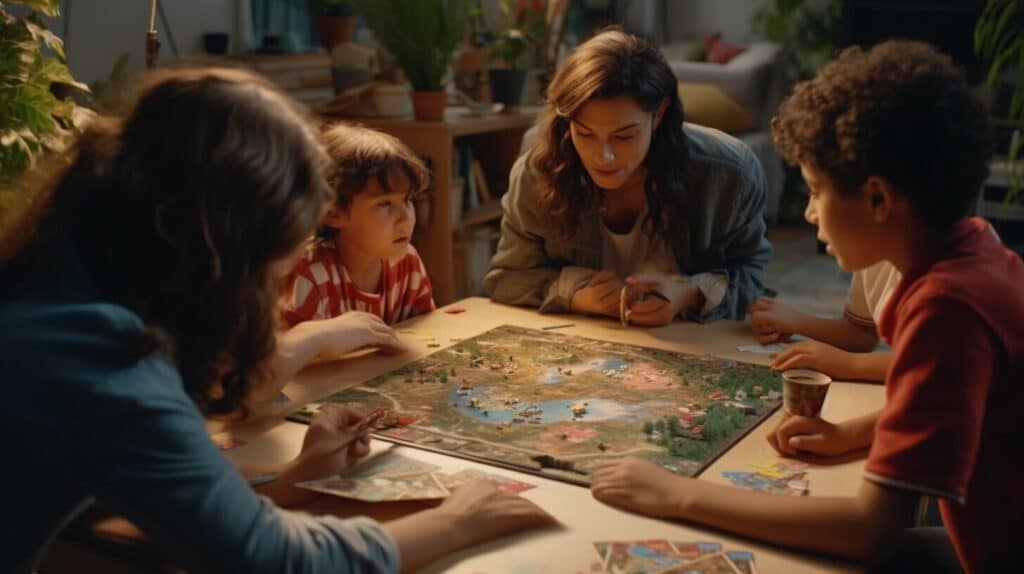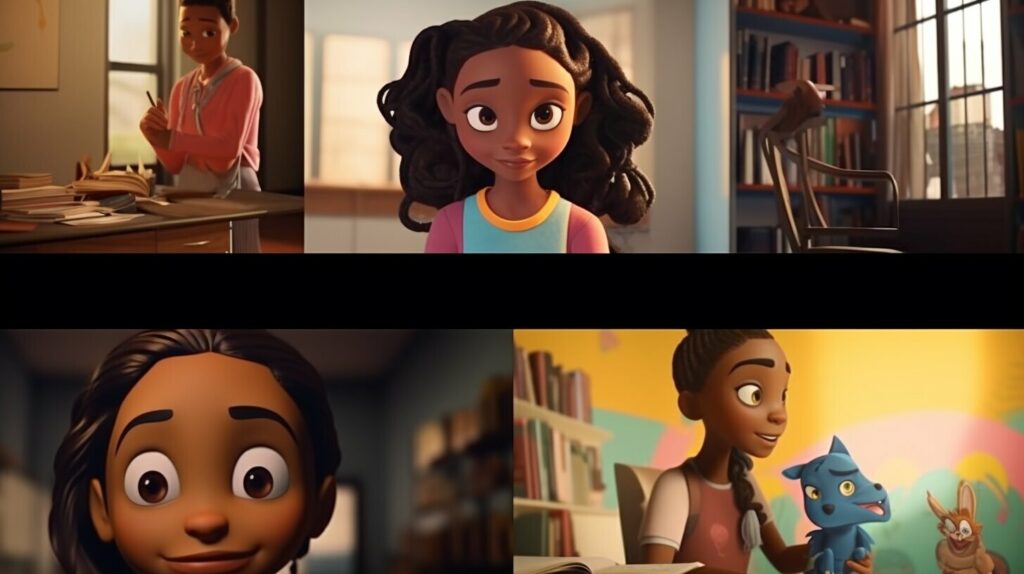Polyamory, or the practice of having multiple loving relationships at the same time, may seem difficult to explain to a child. However, it is important to teach children that love can exist in many forms and that all families and relationships are unique. By introducing polyamory to your child in a sensitive and age-appropriate manner, you can help them develop a positive and accepting attitude towards diversity.
Children can be curious and may have questions about non-traditional relationships. This guide aims to provide you with the tools to approach the topic of polyamory with your child and create a safe space for discussion.
Key Takeaways:
- Teach your child that love can exist in many forms.
- Approach the topic of polyamory in a sensitive and age-appropriate manner.
- Create a safe space for discussion.
- Emphasize the importance of communication, honesty, and trust in all relationships.
- Encourage acceptance and respect for diversity.

Understanding Polyamory: Explaining Love in Diverse Forms
One of the most important aspects of explaining polyamory to a child is helping them understand that love can come in many different forms. You can start by explaining that for some people, love isn’t about finding just one partner to spend their lives with. Instead, some people may find that they’re able to love more than one person at a time.
This may be confusing to a child who’s grown up thinking that love is something that can only happen between two people. But by explaining that love can come in diverse forms, you can help them see that there’s no “right” way to love someone.
It’s important to emphasize that every person’s preferences are unique, and they should never be ashamed or judged for the way they choose to express their love.
Understanding Polyamory: Explaining Love in Diverse Forms
When talking to your child about polyamory, it can be helpful to provide them with some examples of what the relationships might look like. For example, you could explain that some people might have one “primary” partner who they share their life with, but they might also have other partners who they love and care for.
You could also explain that some polyamorous relationships operate as “triads” or “quads,” where three or four people are all in a relationship with each other. In some cases, all partners may share the same level of intimacy and love, while in others, certain partners may have different roles within the relationship.
It can be helpful to let your child know that there’s no one “right” way for a polyamorous relationship to look. Just like monogamous relationships, polyamorous relationships can take many different forms.
Ultimately, the most important thing is that everyone in the relationship is happy, cared for, and feels loved.

“Love isn’t about finding just one partner to spend their lives with. Instead, some people may find that they’re able to love more than one person at a time.
Age-Appropriate Conversations: Teaching Polyamory with Sensitivity
When it comes to explaining polyamory to children, it’s essential to have age-appropriate conversations that are sensitive to their level of understanding. Younger children may have a harder time grasping the concept of non-monogamous relationships, so it’s important to keep explanations simple and avoid overwhelming them with too much information at once.
Start by introducing the idea of love in diverse forms. Explain that some people may love more than one person at the same time and that this is okay as long as everyone involved is happy and consents to the arrangement. Use real-life examples, such as loving multiple children or having close friendships with more than one person, to help children understand that love can be expressed in various ways.
It’s also crucial to emphasize that everyone’s feelings and choices are valid, and no one should feel judged or excluded for their preferences. Use language that supports inclusivity and diversity, such as “different types of families” or “many ways to love.” This approach helps create a safe space for children to ask questions and learn without feeling ashamed or uncomfortable.
As children get older, they may start asking more complex questions about polyamory. Be prepared to discuss the specifics of multiple partners and how they coexist within a relationship. Use visual aids or diagrams if necessary to help them understand how everyone involved communicates and shares love. It’s also essential to explain the importance of communication, honesty, and trust in maintaining healthy relationships, regardless of whether they are monogamous or not.
Remember that children learn by example and through media. Encourage positive role models and showcase examples of healthy polyamorous relationships in books, TV shows, or movies. These models will help normalize diversity, acceptance, and respect for all types of love.
| Key Takeaways: |
|---|
| Introduce diverse forms of love and explain that it’s okay to love more than one person. |
| Use inclusive language and emphasize the validity of everyone’s feelings and preferences. |
| Be prepared to answer more complex questions about multiple partners and communication. |
| Encourage positive role models and use media to teach acceptance and respect for all types of love. |

Explaining Non-Monogamy: Introducing Multiple Partners
Now that your child has a basic understanding of polyamory, it’s time to discuss the concept of non-monogamy and multiple partners. It’s important to make it clear that this is not the same as cheating or dishonesty. In a polyamorous relationship, all partners are aware of and consent to the presence of other partners.
Depending on your child’s age and maturity level, you may want to start with simple examples of non-monogamy, such as having close friendships with more than one person. You can then move on to more complex examples, such as having multiple romantic partners.
Make sure to emphasize that all partners are equal and deserve respect and love. It’s also important to discuss the importance of communication and honesty in these types of relationships.
If your child has questions about jealousy or the potential for conflict in polyamorous relationships, reassure them that these feelings are normal and can be managed through open communication and empathy.
Remember: It’s important to stress that polyamory and non-monogamy are personal choices and not something that everyone will want or choose for themselves.

Having an open and honest conversation about non-monogamy and multiple partners can help your child develop a more nuanced understanding of love and relationships. By emphasizing the importance of communication, empathy, and respect, you can help them develop healthy relationship skills that will serve them well in all types of relationships.
Creating a Safe Space: Addressing Questions and Concerns
As you introduce the concept of polyamory to your child, it’s important to create a safe space for them to ask questions and express their concerns. Let them know that their thoughts and feelings are valid and that you are there to listen and support them throughout the conversation.
When addressing questions and concerns, it’s important to approach the conversation with sensitivity and empathy. Try to put yourself in their shoes and understand where their questions and concerns are coming from.
If your child expresses concerns about jealousy or insecurity in a polyamorous relationship, reassure them that these emotions are normal and can be addressed through open communication and mutual respect. Emphasize that all relationships require work and effort, and that polyamorous relationships are no exception.
It’s also important to address any misconceptions your child may have about polyamory. For example, they may believe that polyamorous relationships involve infidelity or that they are inherently unstable. Use concrete examples and personal experiences to correct any misunderstandings and help them understand the true nature of polyamory.
Remember, creating a safe and supportive space for your child to ask questions and express their concerns is essential in helping them understand and accept the concept of polyamory. By listening to their thoughts and feelings and addressing any misconceptions, you can help them develop a respectful and accepting attitude towards all forms of love and relationships.

Emphasizing Love and Communication: Nurturing Healthy Relationships
One of the most important aspects of polyamory is the emphasis on communication and love. It’s crucial to teach your child that having multiple partners doesn’t mean that you love each partner any less. In fact, it’s quite the opposite! Polyamorous relationships require open and honest communication, which means that all partners have a deep understanding and appreciation for each other.
It’s also important to note that just like in monogamous relationships, healthy boundaries and consent are crucial. This means that all partners involved must discuss and agree on the boundaries of the relationships, making sure that everyone feels comfortable and respected.
When discussing polyamory with your child, emphasize that love is not limited to just one person, and that every person deserves to experience love and happiness in their own unique way. Remind them that regardless of the number of partners involved, the key to a healthy relationship is always open communication and respect.
Encourage your child to ask questions and express any concerns they may have about polyamory. It’s important to create a safe space for them to feel comfortable discussing these topics without judgement or criticism.

“Polyamory is all about communication and love. It’s about embracing a diversity of love and relationships. Teaching your child about polyamory can be an opportunity to promote healthy communication and love in all of their relationships.
Normalizing Diversity: Teaching Acceptance and Respect
One of the most important aspects of teaching children about polyamory is emphasizing the importance of diversity, acceptance, and respect. Just like any other relationship, polyamory is about love, communication, and mutual respect.
It’s important to let your child know that there are many different kinds of love and that polyamory is just one of them. Encourage your child to be open-minded and accepting of all people, regardless of their sexual orientation or relationship status.
| Tip: | Teach your child to use gender-neutral language when speaking about relationships. This includes using “partner” instead of “boyfriend” or “girlfriend. |
|---|
It’s also important to talk to your child about respect and consent in all relationships, including polyamorous ones. Let your child know that it’s not okay to pressure someone into a relationship or force them to do something they’re not comfortable with.
Role models can play an important role in teaching children about acceptance and respect. Look for positive examples of polyamorous relationships in books, TV shows, and movies. Use these examples as a way to start a conversation with your child about healthy relationships and communication.
Remember to always provide a safe space for your child to ask questions and express their concerns. It’s okay if your child doesn’t fully understand polyamory at first, but by fostering an environment of open communication and acceptance, you can help them to learn and grow.
By teaching your child about the importance of diversity, acceptance, and respect, you can help them to become compassionate and empathetic individuals who are accepting of all people.

Honesty and Trust: Instilling Core Values
Polyamorous relationships are built on core values such as honesty, trust, and communication. As you teach your child about polyamory, it is important to emphasize these values and instill them as essential elements of healthy relationships.
Start by explaining the importance of honesty and trust in any relationship, whether monogamous or polyamorous. Let your child know that it is essential to be open and honest with all partners about your feelings, desires, and expectations. This helps to build trust and maintain healthy communication channels throughout the relationship.
As you talk about polyamory, be sure to showcase examples of how honesty and trust are demonstrated in healthy polyamorous relationships. You may also want to discuss how these values can help your child navigate their own relationships in the future, whether they choose to be monogamous or polyamorous.
Additionally, it is important to stress that consent and respect for boundaries are also vital components of polyamorous relationships. Make sure your child understands that it is never okay to pressure someone into any kind of relationship and that they must always respect their partner’s boundaries.
Finally, emphasize the importance of trust in any healthy relationship. Let your child know that they can trust their partners to communicate openly and honestly with them, and that they can trust themselves to do the same. This will help your child build strong, healthy connections with others and maintain fulfilling relationships throughout their life.
Remember, at the heart of polyamory are values that are applicable to all kinds of relationships. By teaching your child about honesty, trust, and communication, you are laying the foundation for them to build healthy relationships, now and in the future.

Role Models and Media: Showcasing Positive Examples
One of the best ways to teach polyamory to a child is by presenting them with positive examples of healthy polyamorous relationships and families. Role models and media can play a crucial role in shaping a child’s understanding of different forms of love.
When selecting role models and media for your child, make sure to choose those that represent healthy, consensual, and respectful polyamorous relationships. Avoid any media that portrays polyamory in a negative or exaggerated manner, as it can create misconceptions and stereotypes in your child’s mind.
Look for books, blogs, and TV shows that depict polyamory in a positive light. The Polyamory Handbook by Peter J. Benson and Opening Up: A Guide to Creating and Sustaining Open Relationships by Tristan Taormino are both excellent resources for adults looking to learn more about polyamory.
For children’s books, Polyamory and Pregnancy by Jessica Burde and The Polyamory Coloring Book by Jessica Fern are both great options. These books can provide a starting point for conversations with your child about different forms of love and relationships.
It’s important to remember that even with positive role models and media, children may still have questions and concerns about polyamory. Encourage open communication and address any issues with sensitivity and understanding.

Addressing Misconceptions: Debunking Myths Surrounding Polyamory
As you introduce the concept of polyamory to your child, it’s crucial to be aware of the myths and misconceptions surrounding it. Addressing these misconceptions can help your child better understand and accept the concept of polyamory.
One common misconception is that polyamory is just an excuse to cheat. This is not true. Polyamory is all about open and honest communication, and all partners involved have given their consent. Cheating involves secrecy and deception, which goes against the principles of polyamory.
Another myth is that polyamory is purely physical and lacks emotional depth. This is also false. Just like any monogamous relationship, polyamorous relationships involve emotional connections and love between partners. The only difference is that there are more people involved.
Some may also believe that polyamorous relationships are inherently unstable and doomed to fail. However, research has shown that the success rates of polyamorous relationships are similar to that of monogamous relationships. The key to a successful polyamorous relationship, just like any relationship, is open and honest communication, trust, and respect.
Finally, it’s important to remember that polyamory is not a “trend” or a “phase.” It’s a valid and legitimate form of love and relationship, just like monogamy. By debunking these myths and misconceptions, you can help your child better understand and accept the concept of polyamory.

Important considerations
In today’s evolving societal landscape, polyamorous parents are increasingly seeking guidance on how to talk to children about polyamory. Navigating the world of polyamorous parenting can be a challenge, especially with the misunderstandings and societal discomfort that surrounds the polyamorous lifestyle. Elisabeth Sheff, a renowned figure in the world of polyamory, as cited by “Psychology Today”, emphasizes the importance of being matter-of-fact when explaining polyamory to kids. Polyamorous parents often grapple with when they should dive into such conversations. The key? Timing and age-appropriate explanations. Parents might wonder, “Is my 7-year-old kid old enough?” or “How do I broach the topic with my teenager?” Regardless of age, children appreciate honesty. They’ll pick up on the interaction between their parent and their parent’s partners, and they’ll have questions.
It’s okay for kids to ask questions. They might want to know about the partners’ roles in the child’s life or even simple things like how holidays are celebrated in a polyamorous household. Many polyamorous parents have told their kids about polyamory openly, ensuring that it’s presented as just another way adults choose to love and form relationships. The intention isn’t to dive into the complexities of adult relationships or the parents’ sex lives, but to provide a matter-of-fact perspective, ensuring kids have a better experience understanding the concept. It’s all about crafting a space where kids feel safe to ask questions, knowing they’ll be met with honest, age-appropriate answers. Furthermore, poly parents must also navigate the challenges of societal perceptions and misconceptions. Kids in the first place, need reassurance that the love in a polyamorous family remains steadfast, even if it doesn’t always align with societal norms. After all, love, whether monogamous or polyamorous, is a vibrant color named love in the palette of human relationships.

Conclusion
Explaining polyamory to a child can be a challenging task, but with sensitivity, honesty, and communication, it is possible to create a safe and nurturing environment to teach them about love in diverse forms. It is important to remember that age-appropriate conversations are key, and that we must be patient and open to answering any questions or concerns that may arise.
By emphasizing the core values of honesty, trust, and communication, and showcasing positive role models in media and real life, we can teach our children to accept and respect diversity and nurture healthy relationships. It is also essential to address misconceptions and debunk myths surrounding polyamory, both for our children’s understanding and for society’s perception of these relationships.
Remember that the most important aspect of explaining polyamory to a child is love. Love is love, no matter how it manifests, and by teaching our children to embrace and celebrate all forms of love, we can build a more tolerant, accepting, and loving society.
Can the Same Approach be Used to Explain Polyamory to a Child as Explaining a Step Dad?
Explaining the concept of polyamory to a child requires a different approach than explaining a step dad. While a step dad explained in child-friendly terms may involve highlighting the addition of a supportive father figure, discussing polyamory might focus on the idea of having multiple loving relationships. Both explanations aim to foster understanding and emphasize the importance of love, albeit in different contexts.
FAQ
Q: What is polyamory?
A: Polyamory is the practice of engaging in multiple romantic or sexual relationships simultaneously, with the consent and knowledge of all parties involved.
Q: How do I explain polyamory to a child?
A: When explaining polyamory to a child, it’s important to emphasize love, communication, and respect. Discussing it in terms of having multiple loving relationships can help them understand.
Q: How do I address questions and concerns from my child about polyamory?
A: Listen attentively to your child’s questions and concerns, validate their feelings, and provide age-appropriate information that helps alleviate their worries. Assure them that it is a normal and valid way for adults to express love.
Q: Are there age-appropriate ways to discuss polyamory with children?
A: Yes, it’s important to tailor the conversation to the child’s developmental stage. Young children may need simple explanations while older children can handle more complex discussions.
Q: Can children understand and accept polyamory?
A: Children have the capacity to understand and accept polyamory when it is presented to them in an age-appropriate way that emphasizes love, communication, and respect.
Q: How do I introduce the concept of multiple partners to my child?
A: Introduce the concept of multiple partners by discussing it in terms of adults having different caring relationships and that love doesn’t have to be limited to just one person.
Q: What values should I emphasize when teaching polyamory to my child?
A: Emphasize values such as honesty, trust, open communication, consent, and respect for others’ boundaries. These values form the foundation of healthy polyamorous relationships.
Q: Are there any positive role models or media examples of polyamory for children?
A: While there may not be many mainstream examples, seek out age-appropriate books, movies, or TV shows that depict diverse relationship styles and showcase healthy forms of love and communication.
Q: How do I debunk myths surrounding polyamory when discussing it with my child?
A: When debunking myths, provide accurate information and counter misconceptions with examples of healthy and consensual polyamorous relationships. Encourage critical thinking and open dialogue.
Q: What are some misconceptions about polyamory that I should address?
A: Some common misconceptions about polyamory include the idea that it is just about sex, that it’s inherently unstable, or that it’s a sign of dissatisfaction with one’s current partner. Addressing these myths can help provide a more accurate understanding.






